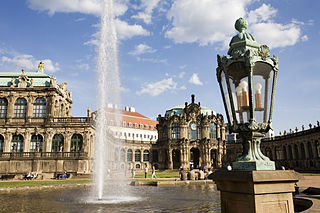
Dresden is the capital city of the German state of Saxony and its second most populous city, after Leipzig. It is the 12th most populous city of Germany, the fourth largest by area, and the third most populous city in the area of former East Germany, after Berlin and Leipzig. Dresden's urban area comprises the towns of Freital, Pirna, Radebeul, Meissen, Coswig, Radeberg and Heidenau and has around 790,000 inhabitants. The Dresden metropolitan area has approximately 1.34 million inhabitants.

Jugendstil was an artistic movement, particularly in the decorative arts, that was influential primarily in Germany and elsewhere in Europe to a lesser extent from about 1895 until about 1910. It was the German counterpart of Art Nouveau. The members of the movement were reacting against the historicism and neo-classicism of the official art and architecture academies. It took its name from the art journal Jugend, founded by the German artist Georg Hirth. It was especially active in the graphic arts and interior decoration.
Jeanne de Salzmann often addressed as Madame de Salzmann was a French-Swiss dance teacher and a close pupil of the spiritual teacher G. I. Gurdjieff.

The Deutscher Werkbund is a German association of artists, architects, designers and industrialists established in 1907. The Werkbund became an important element in the development of modern architecture and industrial design, particularly in the later creation of the Bauhaus school of design. Its initial purpose was to establish a partnership of product manufacturers with design professionals to improve the competitiveness of German companies in global markets. The Werkbund was less an artistic movement than a state-sponsored effort to integrate traditional crafts and industrial mass production techniques, to put Germany on a competitive footing with England and the United States. Its motto Vom Sofakissen zum Städtebau indicates its range of interest.

Mary Wigman was a German dancer and choreographer, notable as the pioneer of expressionist dance, dance therapy, and movement training without pointe shoes. She is considered one of the most important figures in the history of modern dance. She became one of the most iconic figures of Weimar German culture and her work was hailed for bringing the deepest of existential experiences to the stage.
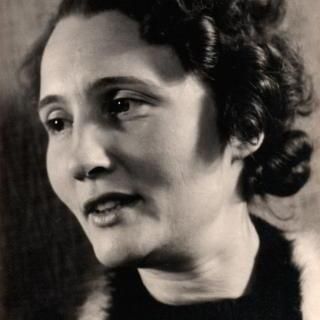
Gerda Alexander was of German / Danish teacher who developed a "bodymind technique" or "somatic practice" known as Eutony. As a young woman, Gerda was in contact with the vanguards of the arts, education, and movement culture in the early 20th century. From the 30's on, she started to develop her innovative method through her studies between movement and musicality, new pedagogies and neurosciences. Through Eutony, she collaborated with many medical centers, pedagogical institutions, and artistic training in Europe, North and South America and the Middle East.
Heinrich Tessenow was a German architect, professor, and urban planner active in the Weimar era.
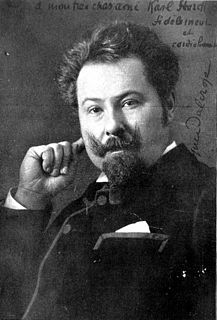
Émile Jaques-Dalcroze was a Swiss composer, musician, and music educator who developed Dalcroze eurhythmics, an approach to learning and experiencing music through movement. Dalcroze eurhythmics influenced Carl Orff's pedagogy, used in music education throughout the United States.
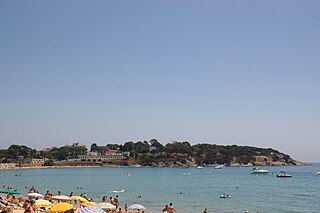
s'Agaró is an upmarket resort on the Costa Brava between Sant Feliu de Guíxols and Platja d'Aro. It is part of the municipality of Castell-Platja d'Aro, itself in the comarca of Baix Empordà and province of Girona in Catalonia, Spain. The resort was developed from the early 1920s on the peninsular between the beaches of Platja de Sant Pol and Platja de Sa Conca.
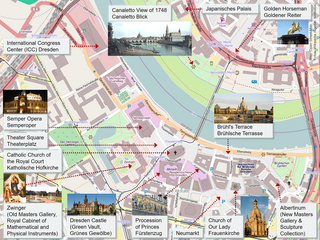
Dresden is a cultural centre in Germany which has influenced the development of European culture. "It is [...] outstanding as a cultural landscape, an ensemble that integrates the celebrated Baroque setting and suburban garden city into an artistic whole within the river valley, and as an example of land use, representing an exceptional development of a major Central-European city."

Festspielhaus Hellerau is a theatre/studio building/classroom building located in Hellerau, the famous garden city district of Dresden, Germany. Built in 1911, it was an important center for early modern theatre up until the rise of the Nazi party, World War II and afterward when the area became part of Communist-occupied East Germany. After the German reunification and the departure of the Red Army, efforts were begun to restore the building, then nearly in ruins, to its original grandeur. The theatre was reopened to the public in September 2006 and restoration is currently ongoing.

Richard Riemerschmid was a German architect, painter, designer and city planner from Munich. He was a major figure in Jugendstil, the German form of Art Nouveau, and a founder of architecture in the style. A founder member of both the Vereinigte Werkstätte für Kunst im Handwerk and the Deutscher Werkbund and the director of art and design institutions in Munich and Cologne, he prized craftsmanship but also pioneered machine production of artistically designed objects.
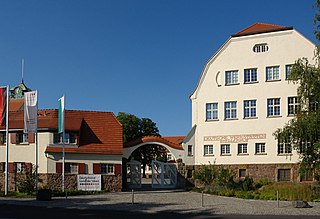
The Deutsche Werkstätten Hellerau is a medium-sized furniture-manufacturing business in the Hellerau district of the German city of Dresden. The company archives are deemed a valuable cultural asset and were provided with legal protection.

Hertha Feist (1896–1990) was a German expressionist dancer and choreographer. She established her own school in Berlin, combining gymnastics with nudism and dance. In the 1930s, her ambitions were seriously curtailed by the Nazis.
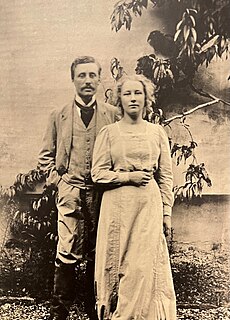
Carl Sattler was a German architect and university lecturer.

Hans Neumeyer was a German teacher of musical theory, counterpoint and composition, and a pianist and composer. He was from a Jewish family in Munich; his father Nathan Neumeyer for a period owned a gentleman’s clothing store in Munich. Hans Neumeyer suffered from an eye complaint as a child, leaving him blind in one eye, then at the age of 11 lost the sight of the other eye after a scuffle at school with a fellow pupil.
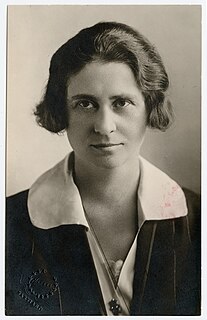
Anne Suzanne "Lili" Ferrière was a Swiss dance teacher of Dalcroze eurhythmics and a humanitarian activist from a prominent Genevan family. As only the third female member of the governing body of the International Committee of the Red Cross (ICRC), she helped to pave the way towards gender equality in the organisation.

The Staaken Garden City is a housing estate located in the Berlin district of Spandau next to the old village of Staaken. It was built between 1914 and 1917 according to the design of the architect Paul Schmitthenner. It is considered one of the most significant urban development achievements of the early 20th century because of the layout of the streets and squares, the intelligent handling of house types and variations, and especially because of its model effect on the Berlin housing estates of the 1920s. The Staaken Garden City was planned with 1000 apartments and a number of public buildings for 5000 inhabitants. Unlike most other projects of this type, size and construction period, it was completed almost entirely within four years according to the original design.

Willy von Beckerath was a German painter and art professor associated with the Düsseldorfer Malerschule. He was primarily known for portraits, landscapes and murals. From 1902, he was instrumental in the formation of the Deutsche Werkstätten Hellerau. He designed furniture and furnishings for churches. From 1907 to 1931, he was professor at the Staatliche Kunstgewerbeschule in Hamburg, where he decorated a new assembly hall with a monumental mural over three of its walls, Die ewige Welle.

Hans Gebhard-Elsaß was a German composer and music educator.
























